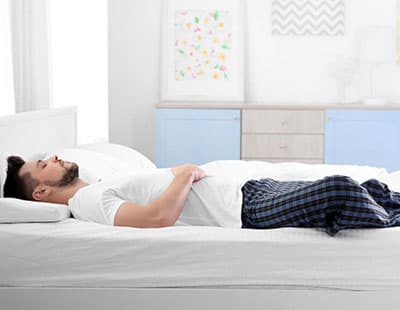The fact that people don't get enough sleep isn't news. Adults should be getting more than 7 hours of sleep every night, but more than half of the adults around the world admit they don't hit that mark. Most people you know (yourself included) probably feel like they would love to sleep better. Whether that's longer, with fewer interruptions, or more restfully, we could all stand to find tips for the best night's sleep.
Tips for the Best Night’s Sleep: Find the Best Pillow
While we all love our pillows for being a soft place to lay our heads, they play a crucial role in our rest and health. The best pillows will support your head, neck, and spine all night long. In addition, they'll keep them in a neutral alignment and support the natural curve of your spine. You'll need to consider your favorite sleeping position to find the best pillow for you.
Real Quick: What’s a Loft?
We’re not talking about attics here. Concerning pillows, loft refers to the thickness. It's also often used interchangeably with height. The lower the loft, the thinner the pillow.
- Low Loft- Pillows three inches thick or less.
- Mid Loft- Pillows between three and five inches thick.
- High Loft- Pillows five inches thick or more.
Are You a Side Sleeper?
Side sleepers will benefit from a lot more support. If you think of your spine like an arrow that shoots out the top of your head, sleeping on your side should make the arrow go into the headboard at a right angle. Firmer support helps accomplish that.
Look for:
- High Loft: A tall profile will prop your head up so it maintains a neutral alignment. It will also relieve pressure in your shoulder, so it's not holding all your body's weight.
- Firm Support: Pillows with firm support will keep your head where it needs to be all night. If it is too soft, your head will sink out of alignment over the night.
- Fluffy and Shapeable: Although it should be firm, that doesn’t have to mean uncomfortable. Fluffable materials like down or down alternatives will be soft but can also be fluffed into a higher loft for sleeping on your side.
Are You a Stomach Sleeper?
While stomach sleeping is the least recommended sleeping position, as per physical therapists, there are still options that will keep your body happy. You're looking for:
- Low Loft: This will keep your posture in line. If your neck is craned up too high, it will throw off the curve of your spine and hurt you.
- Soft Support: Don’t go too firm. You want to be cushioned without craning your neck up.
- Compressible: Compressible pillows like feathers or down alternatives will compress over time, better supporting your head and neck by lowering the loft over the night.
Are You a Back Sleeper?
The back sleepers are the happy medium of the pillow world. Right in the middle of loft and firmness, these people also benefit from compressing pillows like memory foam. So be on the lookout for pillows with the following:
- Medium Loft: Right in the sweet spot, this will keep your head from craning too high up or being flat like you have no pillow. It’ll help relieve pressure in your neck and shoulders.
- Medium Firmness: Firm enough but not too firm; this will keep its shape without feeling like you're sleeping on a rock.
- Conform to Pressure: Materials like memory foam will keep the head cradled and held in neutral alignment while being comfortable.
Tips for the Best Night’s Sleep: Find the Best Bedding
Layer Up
Layering the sheets and blankets on your bed will offer you a quick and easy way to customize your bed at a moment's notice. You can add layers when you're most likely to be chilly and fling them off at night as you get more snuggly and comfortable.
A great guide for layering your bedding is:
- Fitted Sheet on Bottom
- Flat Sheet Next
- Coverlet or Quilt (Can go in any order, but this one is best for warm weather)
- Comforter (Can go in any order, but this one is best for cool weather)
- Throw Blanket (for extra warmth)
Do You Get Hot at Night?
A lot of people suffer from serious temperature fluctuations at night. For example, you might go to bed freezing cold and wake up boiling. For these people, getting sheets and bedding that help regulate your temperature by spreading the heat out evenly, rather than allowing it to pool around your abdomen (where most of your heat is generated), is important.
Look for sheets made from linen, bamboo, or Tencel (made from cellulose from wood like eucalyptus trees). These natural fibers are light and breathable but usually have a good enough weight to support you in bed. If you reside in a colder climate and want something that's still warm but won't let you cook in bed, look for a cotton sheet with a percale weave. The simple criss-cross pattern of the percale weave distributes heat while keeping you safe from the cold weather outside.
Weighted Blankets
You might be missing out if you haven't heard of these yet. Weighted blankets are blankets with weighted materials sewn into them to give them a denser weight than a regular blanket. They have many benefits, from helping people sleep to calming nerves and anxiety. They've been shown to lower heart rates and decrease stress hormones like cortisol and norepinephrine levels. They've even been used successfully to help people with insomnia, other sleep disorders, and attention disorders.
A common question about weighted blankets is, "Can you sleep with them?" For most people, you absolutely can. The weight will help soothe you into a deeper and more restful sleep. However, some people, such as those with obstructive sleep apnea, asthma, or claustrophobia, should talk to a doctor before using a weighted blanket through the night.
Tips for the Best Night’s Sleep: Create the Best Habits
Our sleeping habits as a culture are not great, to say the least. From screen time up until bedtime to poor scheduling and not listening to our bodies, we have bad habits. The good news is that you can develop better habits.
Screen Off Time
Setting a buffer time between bedtime and screen time can allow your brain to calm down and slow down before sleeping. For example, turning your phone off at least thirty minutes before trying to drift off will give your mind and body time to unwind before dropping off to sleep.
Tips for the Best Night’s Sleep: Create a Sleep Schedule
Sleep schedules work great for babies and adults. Going to bed at a routine time and waking at the same time each day is a great way to set a schedule so that your body gets used to going to sleep on time and can start to regulate itself.
Tips for the Best Night’s Sleep: Do Pre-Sleep Meditations
Not all meditations are created the same. Some will help energize and wake you up, whereas others are designed to help you fall into the natural resting rhythms of your body. Finding these meditations and using them in your 30 minutes of screen-free time can prepare your mind and body to sleep restfully.
Sleep Great, Live Better
Finding the best tips and tricks to get a good night's sleep is crucial to having a more joyful and productive life. Getting your hands and head on the best pillows, sheets, and pre-bed habits will make a great night's sleep closer than ever before. Check out the eli&elm for more information on ideas and products to make your sleep rest-ful and complete again.





















